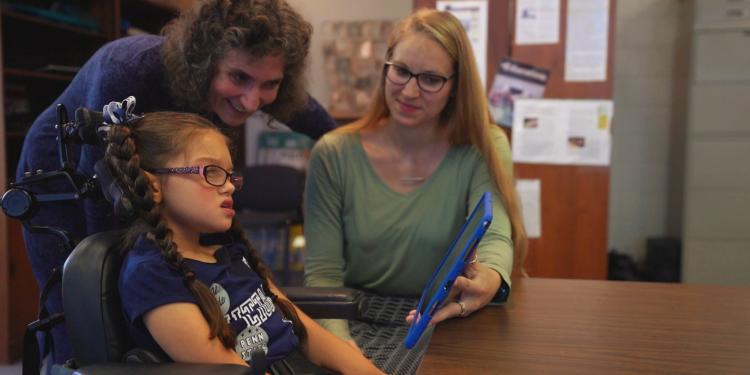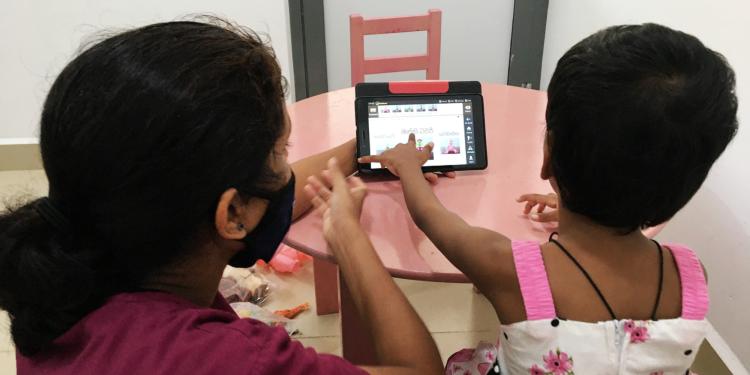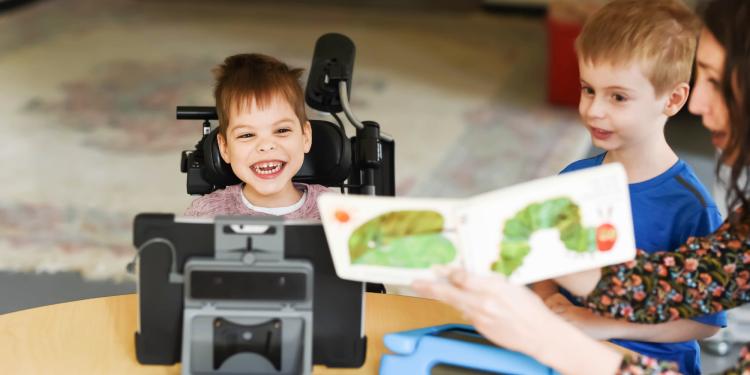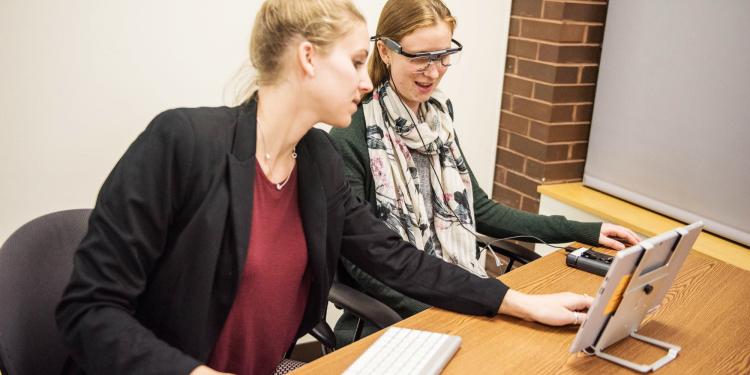Research in Augmentative and Alternative Communication
World-leaders in Augmentative and Alternative Communication
The Penn State program in augmentative and alternative communication (AAC) works to advance knowledge and improve outcomes for individuals who require AAC. Projects range from basic research to clinical evaluation to implementation science.
Research is published in high-quality, peer-reviewed journals and presented at state, national and international conferences to promote the translation of research to practice.

Augmentative and Alternative Communication (AAC) Laboratory
Principal Investigator: Janice Light, Ph.D.
AAC at Penn State | Facebook | Twitter
The RERC on AAC | Facebook | Twitter | Instagram
Studying AAC interventions and technologies to enhance the language development, literacy learning, and communicative competence of individuals with complex communication needs
The AAC lab supports a wide array of activities to improve outcomes for the estimated 5 million Americans, 97 million people worldwide, who have such complex disabilities that they cannot rely on conventional channels of spoken and written communication.
We conduct: research to advance knowledge; development to improve AAC assistive technologies; training to build capacity in the field; and dissemination to support the translation of research to evidence-based practice. Our mission is to enhance communication, increase participation, and improve quality of life for individuals with complex communication needs including children and adults with developmental disabilities (e.g., autism spectrum disorder, cerebral palsy, Down syndrome, etc.), acquired conditions (e.g., traumatic brain injury, spinal cord injury, stroke, etc.), degenerative conditions (e.g., ALS, muscular dystrophy, dementia), and temporary conditions (e.g., those who are intubated due to COVID).
Our work is supported by a wide range of externally funded research and training grants. We are the lead agency for the federally funded Rehabilitation Engineering Research Center on Augmentative and Alternative Communication (The RERC on AAC), a national center for AAC research, development, training, and dissemination.

Augmentative and Alternative Communication (AAC) and Developmental Disabilities Laboratory
Principal Investigator: Kathryn D. R. Drager, Ph.D., CCC-SLP
Studying AAC, Autism, Intervention with Individuals with Severe Disabilities, Low-Resource Communities and Contexts
This lab houses projects that seek to improve the lives of individuals with disabilities of all ages, with an emphasis on school-age children, adolescents, and adults with developmental disabilities, including autism. A particular focus is on daily experiences of individuals and families, and on interventions that can be implemented within daily life.
Studies in this laboratory also examine applications for people within low-resource communities, where technological solutions may not be readily available, including in low- and middle-income countries. The lab is equipped with digital audio and video recording and editing capability.

AAC Language and Bilingualism Lab
Principal Investigator: Gloria Soto, Ph.D.
Studying language development in AAC, bilingual language development in AAC and family-centered AAC practices
The AAC Language and Bilingualism Lab investigates how children and youth with complex communication needs acquire and use language through augmentative and alternative communication (AAC) in both monolingual and multilingual contexts. Our work in grounded in a commitment to communication equity, aiming to develop evidence-based practices that reflect and affirm diverse cultural and linguistic identities. Current research in the lab focuses on three interconnected themes:
- Language Development in AAC: We study how children acquire vocabulary, grammar and discourse skills through AAC, and design interventions to improve language outcomes, grounded in authentic communicative experiences (e.g., conversation, narratives), interactive conversational repair, and plentiful opportunities for practice within naturally occurring interactions.
- Bilingual Language Development in AAC: We examine how children who use AAC learn and use multiple languages across home, school, and community settings, and design interventions that leverage all of a child's languages and modalities into authentic interactions, family routines, and educational activities to promote culturally and linguistically affirming communication and participation.
- Family-Centered AAC Practices: Recognizing the central role of parents and primary caregivers in children's communication development, we investigate collaborative, co-designed culturally responsive approaches to AAC assessment, goal-setting, and intervention that strengthen partnerships between families and professionals.

Augmentative and Alternative Communication (AAC) and Literacy Lab
Principal Investigator: Jessica Caron, Ph.D., CCC-SLP
Studying AAC, Literacy, Training Supports, and Implementation Science
This lab houses state of the art AAC technology designed to support individuals with complex communication needs. Video equipment and computers are also available and equipped for analyzing and editing video. Testing instruments for assessing language, communication, and literacy is also available.
Research in the laboratory focuses on improving communication and literacy outcomes for individuals with a range of disabilities, including children, adolescents, and adults.
Specifically, the ongoing research projects in this laboratory are investigating implementation science variables related to the: (a) development of evidence-based literacy practices for individuals who use AAC, (b) knowledge transfer and training of evidence-based practices to relevant stakeholders, and (c) variables that support sustained and larger-scale implementation of adapted literacy instruction for individuals who have limited or no speech.

Inter-AACtion Lab
Principal Investigator: Michael Clarke, PhD., CCC-SLP
Studying language learning, interpersonal interaction and social participation of children using AAC tools to inform technology design
The Inter-AACtion Lab investigates clinical and theoretical questions to better understand and support communication between children using augmentative and alternative communication (AAC) tools and their partners. Current research is clustered around four themes:
- Interpersonal Interaction and Social Participation: Using principles and practices from Conversation Analysis, we explore how children using AAC and their partners achieve shared meaning, employ multimodal resources, address communication challenges, and adapt their interactions for mutual benefit.
- Assessment and Use of Looking Skills: For nonspeaking children with physical disabilities, controlled gaze behaviors (fixations, shifts) can be a vital aspect of communication and offer access to gaze-control technologies. However, gaining a clear understanding of these children's use of functional vision can be challenging. This theme aims to develop tools and strategies for families and clinicians to better assess and support functional vision for communication.
- Language Learning: While language typically develops through everyday interaction with parents, peers, and teachers, for children who primarily use graphic symbol-based speech generating devices (SGDs) opportunities for such rich and meaningful language exposure may be limited. This theme explores ways to support interaction-based language learning and to examine language learning trajectories by children using SGDs.
- Interaction-Informed Technology Design: Rapid technological advances create exciting opportunities to reimagine AAC systems. This theme investigates how AAC design and AAC interventions can by advanced by integrating family values and our understanding of the dynamics of human interaction with advances in artificial intelligence.

Laboratory for the Study of Visual Supports in Communication and Education
Principal Investigator: Krista Wilkinson, Ph.D.
Studying communication/language in developmental and intellectual disabilities, visual-perceptual processes, eyetracking
This lab seeks to improve the effectiveness of visual supports used in communication intervention for individuals with developmental and intellectual disabilities. Many such children use visual schedules, calendars, or communication books that have pictures of upcoming activities, desired foods, friends, or favorite social activities. The studies in this laboratory examine how systematic consideration of the construction of these displays (placement and color of the symbols on the aid, for instance) might influence functional communication or learning outcomes. The research includes basic studies of visual processing conducted within the laboratory as well as applied instructional procedures embedded within storybook reading activities that take place in children’s homes or schools. Future planned studies include neuro-imaging studies that will allow us to examine brain responses to the visual communication symbols presented on the displays.



